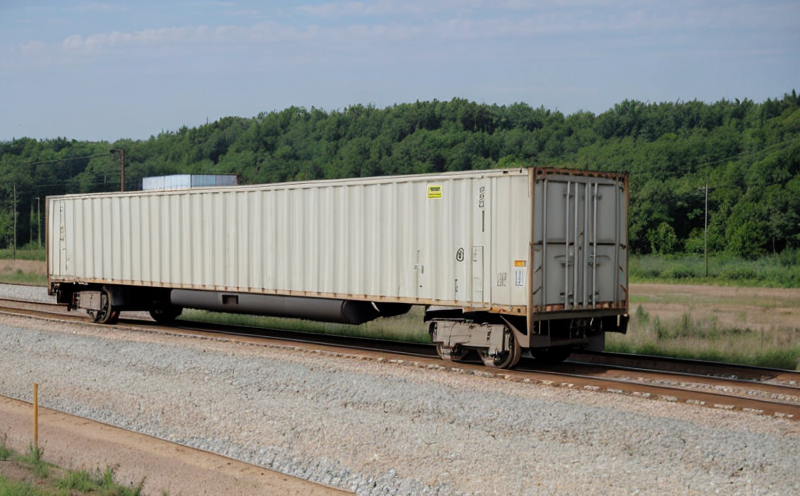UIC 573 Side Impact Testing of Freight Wagons
The UIC (Union Internationale des Chemins de Fer) Standard 573 is a pivotal requirement for the railway industry, ensuring that freight wagons are capable of withstanding significant lateral impacts without compromising safety and structural integrity. This test evaluates the ability of a wagon to resist damage under realistic conditions that could occur during transportation.
The UIC 573 testing protocol involves subjecting a representative section of the cargo wagon to controlled side impacts using a standardized impactor. The primary goal is to assess how well the design withstands lateral forces, which are critical in preventing derailment and ensuring passenger and cargo safety. This test is particularly important for freight wagons as they often carry heavy loads and operate under varying environmental conditions.
The testing process involves several key steps:
- Preparation of the wagon section to be tested
- Alignment of the impactor with the target area on the wagon
- Careful calibration of the test parameters to ensure accurate and repeatable results
- Data recording during testing, including force measurements, displacement, and structural deformation
The UIC 573 standard is widely recognized for its stringent requirements. It aims to provide a comprehensive evaluation of the wagon's resilience under lateral impacts by simulating real-world conditions such as collisions with other vehicles or obstacles on the track.
For quality managers and compliance officers, this test ensures that their freight wagons meet international safety standards, thereby reducing risks associated with derailment and enhancing overall transportation reliability. For R&D engineers, it offers a critical benchmark for designing more robust and safer wagons. Procurement professionals can leverage these tests to select suppliers who adhere strictly to UIC 573 requirements.
The testing apparatus used in this procedure typically includes specialized impact machines capable of generating controlled lateral forces. These machines are calibrated according to the latest versions of international standards such as ISO, ASTM, and EN, ensuring accurate and reliable results.
Once the test is completed, a detailed report is generated, outlining all relevant parameters measured during the experiment. This document serves as an essential tool for quality assurance departments and helps in continuous improvement initiatives aimed at enhancing wagon design and performance.
Applied Standards
| Standard | Description |
|---|---|
| UIC 573-1:2020 | Provisions for impact testing of freight wagons |
| ISO 6852:2019 | Impact testing of railway vehicles - Test methods and criteria |
| ASTM E364-17 | Standard test method for impact strength of plastics |
| EN 15227:2008 | Railway applications - Impact tests on railway wagons and their parts |
Why Choose This Test
The UIC 573 side impact test is an indispensable part of the railway industry's quality assurance process. It ensures that freight wagons can withstand the stresses and strains they encounter during transportation, thereby enhancing safety and reliability.
By choosing this test, stakeholders benefit from:
- Compliance with international standards
- Rigorous assessment of structural integrity
- Enhanced safety measures for passengers and cargo
- Continuous improvement in design and manufacturing processes
- Data-driven decision-making for procurement and R&D initiatives
The test results provide valuable insights into the performance of freight wagons under lateral impacts, which can inform future design improvements. This ensures that railway transportation remains safe and efficient, meeting both current and future demands.
Furthermore, adhering to UIC 573 standards enhances a company's reputation in the global market by demonstrating a commitment to high-quality products and services. It also opens doors for international collaborations and partnerships within the industry.
International Acceptance and Recognition
The UIC 573 side impact test is highly respected in the global railway community, recognized by major organizations such as the International Union of Railways (UIC) itself. It is a cornerstone for ensuring that freight wagons meet stringent safety requirements.
Many countries have integrated this standard into their national regulations, making it mandatory for manufacturers and operators to comply with UIC 573 during design, manufacturing, and periodic inspections. This international acceptance underscores the importance of adhering to such rigorous testing protocols.
The widespread adoption of UIC 573 has led to a harmonized approach in railway safety standards across different regions. This consistency not only simplifies compliance for companies but also enhances overall transportation efficiency by reducing discrepancies between national regulations.
International recognition of this test also fosters trust among stakeholders, including passengers, shippers, and regulators. By ensuring that freight wagons meet UIC 573 standards, railway operators can offer a safer and more reliable service to the public.





